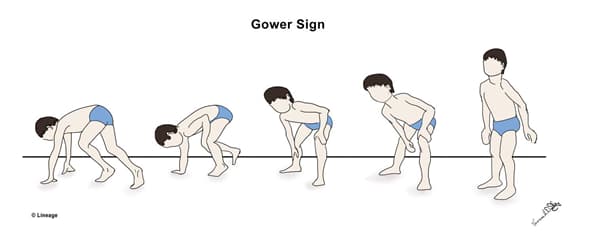Overview

Snapshot
- A 4-year-old boy is brought to his pediatrician by his mother for muscle weakness. She reports that he has trouble running with his friends and climbing the stairs. She also states that the patient has increased difficulty arising from a seated position on the ground and walks in a “waddling” way. On physical exam, there is significant proximal muscle weakness and pseudohypertrophy of the bilateral calves. He also has Gower sign. Laboratory testing is notable for a significantly elevated creatine kinase and aldolase. A sample is obtained for genetic analysis of the dystrophin gene. (Duchenne muscular dystrophy)
Introduction
- Clinical definition
- inherited disorder of skeletal muscle leading to progressive muscle weakness
- Epidemiology
- incidence
- Duchenne muscular dystrophy
- most common early onset form
- Becker muscular dystrophy
- a relatively common form that typically presents later in life
- Duchenne muscular dystrophy
- demographics
- male children
- recall that males have only one X chromosome
- male children
- incidence
- Etiology
- Pathogenesis
- normal biology
- dystrophin is one of the largest human genes and appears to be involved in
- preventing muscle fiber degeneration by providing mechanical stability between the myofiber and its cell membrane
- connecting actin to α- and β-dystroglycan transmembrane proteins
- cell signaling
- preventing muscle fiber degeneration by providing mechanical stability between the myofiber and its cell membrane
- dystrophin is expressed in cardiac, skeletal, and neural tissue
- dystrophin is one of the largest human genes and appears to be involved in
- pathology
- absent or decreased function of dystrophin leads to cycles of muscle fiber degeneration and regeneration
- this subsequently leads to fatty replacement and a distorted fascicular architecture
- absent or decreased function of dystrophin leads to cycles of muscle fiber degeneration and regeneration
- normal biology
- Prognosis
- Duchenne muscular dystrophy
- mean age of death is 25-30 years of age and death results from
- heart failure
- respiratory failure
- mean age of death is 25-30 years of age and death results from
- Becker muscular dystrophy
- Duchenne muscular dystrophy
- less severe than Duchenne muscular dystrophy
Presentation
- Symptoms
- progressive muscle weakness
- most severe in the proximal muscles and lower extremity
- waddling gait
- progressive muscle weakness
- Physical exam
- Gower sign
- a patient using their upper extremity to stand
- signifies weakness of the proximal lower extremity muscles
- a patient using their upper extremity to stand
- calf pseudohypertrophy
- lumbar lordosis
- Gower sign
- hypo- or areflexia
Studies
- Labs
- ↑ serum creatine kinase
- ↑ aldolase, alanine transaminase, and aspartate transaminase
- Genetic testing
- confirms the diagnosis
- Dystrophin analysis
- Duchenne muscular dystrophy
- complete or almost complete loss of dystrophin
- Becker muscular dystrophy
- dystrophin with abnormal molecular weight
- reduced quantity of dystrophin
- Duchenne muscular dystrophy
- Biopsy
- muscle fibril degeneration, regeneration, and isolated fiber hypertrophy
- muscle replacement with fat and connective tissue
- performed if genetic testing is negative
Differential
- Limb-girdle muscular dystrophy
- Spinal muscular atrophy
Treatment
- Management approach
- treatment for both Duchenne and Becker muscular dystrophy is multidisciplinary to manage symptoms and complications
- Medical
- glucocorticosteroids
- indication
- mainstay of treatment for patients with Duchenne muscular dystrophy
- drugs
- prednisone
- deflazacort
- adverse effects
- weight gain
- hirsutism
- indication
- glucocorticosteroids
- cushingoid appearance
Complications
- Muscular
- wheel chair bound
- Cardiac
- dilated cardiomyopathy
- arrhythmia
- Orthopedic
- fractures secondary to falling


